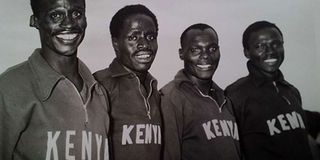Bartonjo Rotich: Curtain falls on pioneer track star

Bartonjo Rotich (right) with Kenya’s 440 yards relay team. Left to right: Kiptalam Keter, Sila Boit, Wanyoike Kamau, in Melbourne, Australia, in 1956. PHOTO | FILE |
What you need to know:
- In November 1960, Bartonjo went to Cambridge University and later in Oxford University where he studied Public Administration.
- On his return, he was appointed as a District Assistant and posted to Murang’a and later Lodwar in Turkana where he rose to become the District Commissioner in Kisumu and thereafter to Nairobi where he worked for a number of years.
On Monday, the first Kenyan to ever win an international athletics medal, Mzee Bartonjo Rotich, breathed his last.
Bartonjo, who is famous for bagging a bronze medal in the Commonwealth Games in Cardiff, Wales, in 1958, died peacefully in his sleep at his Ainabkoi home in Baringo North at the age of 82.
The Cardiff competitions in which he won was Kenya’s third international athletics competition having participated in Commonwealth Games in Vancouver, Canada, in 1954, and the Olympics in Melbourne Australia in 1956, all without any medals. Bartonjo broke that drought.
He was born in 1937 in Kabartonjo in Baringo North, the first eight children of Kamuren Rotich.
He used the money he earned as a herdsman to pay school fees and ran six miles every morning to be in school by 7am, running back to herd the goats after.
In 1945, he joined the Government African School Kabarnet and it was here that he was taught by former President Daniel arap Moi.
In 1949, he attended the Government African School Kapsabet (now Kapsabet High School) where his athletics talent was discovered.
He soon became a star athlete in the school upsetting the established runners and fellow schoolmates, Paul and Sila Boit, in the 440 and 880 yards (quarter and half mile).
On June 5, 1954, Bartonjo, then 17, took part in the Rift Valley Provincial Championships winning in the 440 and 880 yards, qualifying for the National Championships.
He then took part in the Inter-Territorial games held on June 19 1954 in Nairobi and it was here that the Colony Sports Officer Archie Evans, discovered him.
Evans was also the national athletics coach and used the Inter-Territorial games (which brought in Kenya, Uganda, Tanganyika and Zanzibar), to select the team to represent Kenya in the British Empire Games in Vancouver, Canada. Bartonjo made the cut for the team but at 17 he was considered a minor.
On August 27, 1955, Bartonjo set the national record in the 4x440y known as the mile relay clocking a time of 3:20.8 together with Sila Boit his former rival now turned teammate.
The others in the team were Wanyoike Kamau of the Kenya Police and Kiptalam Keter. In April 1956, Bartonjo was part of the Rift Valley team of ‘Olympic Games possibles’, the elite Kenyan athletes selected to be specially trained at Jeanes School Kabete to ahead of the XVI Olympiad in Melbourne Australia.
In July 18, 1956, Bartonjo set the national record in the 440 yards clocking 49.8 seconds which he soon broke it to post a time 48.4 during the Inter-territorial games on September 16, 1956 in Moshi, in then Tanganyika.
He boarded a plane for the first time in his life heading for Australia in November 1956. Bartonjo ran the 300m clocking a time of 30.6 on November 17, 1956 and which was recognized by the KAAA as a new national record.
This was the first time he had ran a race shorter than his accustomed 440yards. He had his school fees cleared at Kapsabet for doing the Nation proud.
In 1960 several American universities came calling for Bartonjo to study in America. These included Colgate University, Hamilton, New York University among others. Then, the Kenya Army wanted to recruit him but he had already joined the Provincial Administration.
In November 1960, Bartonjo went to Cambridge University and later in Oxford University where he studied Public Administration.
On his return, he was appointed as a District Assistant and posted to Murang’a and later Lodwar in Turkana where he rose to become the District Commissioner in Kisumu and thereafter to Nairobi where he worked for a number of years.
He was elected in February 1971 to become the chairman of the Kenya Amateur Athletics Association (KAAA) where he served for five years.
Had 12 children
Bartonjo left the Provincial Administration and joined Brooke Bond in Kericho as the Marketing Manager for a number of years and later tried his hand in politics in 1974 running for Eldoret South seat but lost to Charles Murgor.
The retired athlete later became the Chairman of the Horticultural Development Corporation of Kenya (HCDA) and also a director at the Kenya Airports Authority before he returned to his Ainabkoi farm and remained there until his demise. He had married twice and had 12 children.
In an excerpt of the upcoming book ‘The Kenyan Running Legends: A history of Athletics in Kenya 1922-1972” by Godfrey K. Sang and Capt. (Rtd) Ken Boit, the Octogenerian is quoted in 2013 saying: “The government should encourage the old athletes with a pension.
The younger athletes should be given training to assist them invest their earnings.” Sadly, he died without the government meeting his dream.





